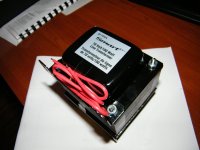While rummaging through boxes at my parent's house the other day, I discovered a brand new 70-Volt/100-Watt Line Transformer which I remember buying from Radio Shack years ago, but not really knowing what to do with it. I still don't know what to do with it. 🙂
Attached is a photo. The only labelling is what you see there. It has a Radio Shack catalog number of 32-1032A but Googling this didn't help me. How am I supposed to know which end is the primary? One side has two red leads and the other side has two yellow leads. It says nothing about impedances, just 70-volts and 100-watts.
It's in perfect mint condition. What should I do with this besides trying to sell it off (I prefer keeping it)? I read up on what these kinds of line transformers are basically for, to allow connecting many parallel speakers to an amplifier, and allowing each to be controlled separately, or something like that.
Attached is a photo. The only labelling is what you see there. It has a Radio Shack catalog number of 32-1032A but Googling this didn't help me. How am I supposed to know which end is the primary? One side has two red leads and the other side has two yellow leads. It says nothing about impedances, just 70-volts and 100-watts.
It's in perfect mint condition. What should I do with this besides trying to sell it off (I prefer keeping it)? I read up on what these kinds of line transformers are basically for, to allow connecting many parallel speakers to an amplifier, and allowing each to be controlled separately, or something like that.
Attachments
They are used in distributed "constant voltage" sound systems. Traditionally, you have two of those in the most basic of distributed systems. One at the amp and one at the speaker. Because you are stepping up the amps output voltage and then stepping it back down at the other end, losses on very long wire lengths are minimized. It's the same concept as power distribution.
You can also add many speakers each with a stepdown transformer in parallel, and the impedance the amp sees changes very little. As long as you don't load the transformer at the amp end above it's power rating, you're ok. Usually the transformer at the speaker end has multiple taps to select max power available to the speaker.
Modern amps designed for these systems don't need the transformer you have. It is either built in or the output section of the amp can drive the system directly.
You can also add many speakers each with a stepdown transformer in parallel, and the impedance the amp sees changes very little. As long as you don't load the transformer at the amp end above it's power rating, you're ok. Usually the transformer at the speaker end has multiple taps to select max power available to the speaker.
Modern amps designed for these systems don't need the transformer you have. It is either built in or the output section of the amp can drive the system directly.
Rane has a good paper on "Constant Voltage Audio Distribution Systems"
Constant-Voltage Audio Distribution Systems: 25, 70.7 & 100 Volts
Constant-Voltage Audio Distribution Systems: 25, 70.7 & 100 Volts
- Status
- Not open for further replies.
